Climate Variability and Trends in Imotski, Croatia: An Analysis of Temperature and Precipitation
Abstract
1. Introduction
2. Materials and Methods
2.1. Study Area
2.2. Data
2.3. Homogeneity of Data and Differences between Two Time Series
2.4. Trend and Variability Analysis
3. Results and Discussion
3.1. Analysis of Air Temperature Dynamics
3.2. Analysis of Precipitation
3.2.1. Precipitation Analysis on Monthly Scale
3.2.2. Spatial Distribution of Precipitation
3.2.3. Precipitation Analysis on Annual Scale
4. Conclusions
Author Contributions
Funding
Institutional Review Board Statement
Informed Consent Statement
Data Availability Statement
Conflicts of Interest
References
- Lavell, A.; Oppenheimer, M.; Diop, C.; Hess, J.; Lempert, R.; Li, J.; Muir-Wood, R.; Myeong, S.; Moser, S.; Takeuchi, K.; et al. Climate Change: New Dimensions in Disaster Risk, Exposure, Vulnerability, and Resilience. In Managing the Risks of Extreme Events and Disasters to Advance Climate Change Adaptation: Special Report of the Intergovernmental Panel on Climate Change; Cambridge University Press: Cambridge, UK; New York, NY, USA, 2012; pp. 25–64. [Google Scholar]
- Moatti, J.-P.; Thiébault, S. The Mediterranean Region under Climate Change. A Scientific Update: Abridged English/French Version; Allenvi: Marseille, France, 2016. [Google Scholar]
- Pastor, F.; Valiente, J.A.; Khodayar, S. A Warming Mediterranean: 38 Years of Increasing Sea Surface Temperature. Remote. Sens. 2020, 12, 2687. [Google Scholar] [CrossRef]
- Giorgi, F. Climate Change Hot-Spots. Geophys. Res. Lett. 2006, 33, 101029. [Google Scholar] [CrossRef]
- Lionello, P.; Gacic, M.; Gomis, D.; Garcia-Herrera, R.; Giorgi, F.; Planton, S.; Trigo, R.; Theocharis, A.; Tsimplis, M.N.; Ulbrich, U.; et al. Program Focuses on Climate of the Mediterranean Region. Eos Trans. Am. Geophys. Union 2012, 93, 105–106. [Google Scholar] [CrossRef]
- Gajić-Čapka, M.; Cindrić, K.; Pasarić, Z. Trends in Precipitation Indices in Croatia, 1961–2010. Theor. Appl. Climatol. 2015, 121, 167–177. [Google Scholar] [CrossRef]
- Ali, E.; Cramer, W.; Carnier, J.; Georgopoulou, E.; Hilmi, N.; le Cozannet, G.; Lionello, P. Cross-Chapter Paper 4: Mediterranean Region. In Climate Change 2022: Impacts, Adaptation and Vulnerability; Cambridge University Press: Cambridge, UK; New York, NY, USA, 2022; pp. 2233–2272. [Google Scholar]
- Todaro, V.; D’Oria, M.; Secci, D.; Zanini, A.; Tanda, M.G. Climate Change over the Mediterranean Region: Local Temperature and Precipitation Variations at Five Pilot Sites. Water 2022, 14, 2499. [Google Scholar] [CrossRef]
- Giorgi, F. Variability and Trends of Sub-Continental Scale Surface Climate in the Twentieth Century. Part I: Observations. Clim. Dyn. 2002, 18, 675–691. [Google Scholar] [CrossRef]
- Ulbrich, U.; Xoplaki, E.; Dobricic, S.; García-Herrera, R.; Lionello, P.; Adani, M.; Baldi, M.; Barriopedro, D.; Coccimiglio, P.; Dalu, G.; et al. Past and Current Climate Changes in the Mediterranean Region. In Regional Assessment of Climate Change in the Mediterranean: Volume 1: Air, Sea and Precipitation and Water; Springer: Dordrecht, The Netherlands, 2013; pp. 9–51. [Google Scholar]
- Lionello, P.; Malanotte-Rizzoli, P.; Boscolo, R.; Alpert, P.; Artale, V.; Li, L.; Luterbacher, J.; May, W.; Trigo, R.; Tsimplis, M.; et al. The Mediterranean Climate: An Overview of the Main Characteristics and Issues. Dev. Earth Environ. Sci. 2006, 4, 1–26. [Google Scholar]
- Philandras, C.M.; Nastos, P.T.; Kapsomenakis, J.; Douvis, K.C.; Tselioudis, G.; Zerefos, C.S. Long Term Precipitation Trends and Variability within the Mediterranean Region. Nat. Hazards Earth Syst. Sci. 2011, 11, 3235–3250. [Google Scholar] [CrossRef]
- Mariotti, A.; Pan, Y.; Zeng, N.; Alessandri, A. Long-Term Climate Change in the Mediterranean Region in the Midst of Decadal Variability. Clim. Dyn. 2015, 44, 1437–1456. [Google Scholar] [CrossRef]
- Flaounas, E.; Drobinski, P.; Vrac, M.; Bastin, S.; Lebeaupin-Brossier, C.; Stéfanon, M.; Borga, M.; Calvet, J.-C. Precipitation and Temperature Space–Time Variability and Extremes in the Mediterranean Region: Evaluation of Dynamical and Statistical Downscaling Methods. Clim. Dyn. 2013, 40, 2687–2705. [Google Scholar] [CrossRef]
- Zaninovič, K.; Gajić-Čapka, M. Climate Change and the Influence on Health [Klimatske Promjene i Utjecaj Na Zdravlje]. Infektoloski Glas. 2008, 28, 5–15. [Google Scholar]
- Beslik, S.; Causevic, A. Climate Risk Assessment Report: Croatia; Nordea: Helsinki, Finland, 2019. [Google Scholar]
- Branković, Č.; Cindrić, K.; Gajić-Čapka, M.; Güttler, I.; Patarčić, M.; Srnec, L.; Vučetić, V.; Zaninović, K. Peto Nacionalno Izvješće Republike Hrvatske Prema Okvirnoj Konvenciji Ujedinjenih Naroda o Promjeni Klime (UNFCCC); Izabrana Poglavlja: Opažene Klimatske Promjene u Hrvatskoj Scenarij Klimatskih Promjena Utjecaj Klimatskih Varijacija i Promjena Na Biljke i Na Opasnost Od Šumskih Požara; DHMZ: Zagreb, Croatia, 2009. [Google Scholar]
- Bonacci, O. Analiza Nizova Srednjih Godišnjih Temperatura Zraka u Hrvatskoj. Građevinar 2010, 62, 781–791. [Google Scholar]
- Bonacci, O. Increase of Mean Annual Surface Air Temperature in the Western Balkans during Last 30 Years. Vodoprivreda 2012, 40, 75–89. [Google Scholar]
- Gajić-Čapka, M.; Cindrić, K. Secular Trends in Indices of Precipitation Extremes in Croatia, 1901–2008. Geofizika 2011, 28, 293–312. [Google Scholar]
- Bonacci, O.; Andrić, I.; Vrsalović, A.; Bonacci, D. Precipitation Regime Changes at Four Croatian Meteorological Stations. Atmosphere 2021, 12, 885. [Google Scholar] [CrossRef]
- Bonacci, O. Air Temperature and Precipitation Analyses on a Small Mediterranean Island: The Case of the Remote Island of Lastovo (Adriatic Sea, Croatia). Acta Hydrotech. 2019, 32, 135–150. [Google Scholar] [CrossRef]
- Gajić-Čapka, M.; Tadić, M.P.; Patarčić, M. Digitalna Godišnja Oborinska Karta Hrvatske. Hrvat. Meteoroloski Cas. 2003, 38, 21–33. [Google Scholar]
- Zdilar, S. Reljef Zavale Imotskog Polja i Njegovo Geoekološko Vrednovanje; Augustini: Zagreb, Croatia, 2001. [Google Scholar]
- Bonacci, O.; Roje-Bonacci, T. Interpretation of Groundwater Level Monitoring Results in Karst Aquifers: Examples from the Dinaric Karst. Hydrol. Process. 2000, 14, 2423–2438. [Google Scholar] [CrossRef]
- Vrsalović, A.; Andrić, I.; Buzjak, N.; Bonacci, O. Karst Lake’s Dynamics Analysis as a Tool for Aquifer Characterisation at Field Scale, Example of Cryptodepression—Red Lake in Croatia. Water 2022, 14, 830. [Google Scholar] [CrossRef]
- Bonacci, O.; Andrić, I. Morphological Study of Red Lake in Dinaric Karst Based on Terrestrial Laser Scaning and Sonar System. Acta Carsologica 2014, 43, 229. [Google Scholar] [CrossRef]
- Bonacci, O.; Željković, I.; Galić, A. Karst Rivers’ Particularity: An Example from Dinaric Karst (Croatia/Bosnia and Herzegovina). Environ. Earth Sci. 2013, 70, 963–974. [Google Scholar] [CrossRef]
- Bonacci, O.; Roje-Bonacci, T. Water Losses from the Ričice Reservoir Built in the Dinaric Karst. Eng. Geol. 2008, 99, 121–127. [Google Scholar] [CrossRef]
- Šegota, T.; Filipčić, A. Köppenova Podjela Klima i Hrvatsko Nazivlje. Geoadria 2003, 8, 17–37. [Google Scholar] [CrossRef]
- Bonacci, O.; Željković, I.; Trogrlić, R.Š.; Milković, J. Differences between True Mean Daily, Monthly and Annual Air Temperatures and Air Temperatures Calculated with Three Equations: A Case Study from Three Croatian Stations. Theor. Appl. Climatol. 2013, 114, 271–279. [Google Scholar] [CrossRef]
- Bezak, N.; Cerović, L.; Šraj, M. Impact of the Mean Daily Air Temperature Calculation on the Rainfall-Runoff Modelling. Water 2020, 12, 3175. [Google Scholar] [CrossRef]
- Weiss, A.; Hays, C.J. Calculating Daily Mean Air Temperatures by Different Methods: Implications from a Non-Linear Algorithm. Agric. Meteorol. 2005, 128, 57–65. [Google Scholar] [CrossRef]
- Gough, W.A.; Žaknić-Ćatović, A.; Zajch, A. Sampling Frequency of Climate Data for the Determination of Daily Temperature and Daily Temperature Extrema. Int. J. Climatol. 2020, 40, 5451–5463. [Google Scholar] [CrossRef]
- Bonacci, O.; Željković, I. Differences between True Mean Temperatures and Means Calculated with Four Different Approaches: A Case Study from Three Croatian Stations. Theor. Appl. Climatol. 2018, 131, 733–743. [Google Scholar] [CrossRef]
- Conner, G.; Foster, S. Searching for the Daily Mean Temperature. In Proceedings of the 17th Conference on Applied Climatology, 88th Annual Meeting American Meteorological Society, Whistler, BC, Canada, 11–15 August 2008. [Google Scholar]
- Alexandersson, H. A Homogeneity Test Applied to Precipitation Data. J. Climatol. 1986, 6, 661–675. [Google Scholar] [CrossRef]
- Costa, A.C.; Soares, A. Homogenization of Climate Data: Review and New Perspectives Using Geostatistics. Math. Geosci. 2009, 41, 291–305. [Google Scholar] [CrossRef]
- Wijngaard, J.B.; Klein Tank, A.M.G.; Können, G.P. Homogeneity of 20th Century European Daily Temperature and Precipitation Series. Int. J. Climatol. 2003, 23, 679–692. [Google Scholar] [CrossRef]
- Sen, P.K. Estimates of the Regression Coefficient Based on Kendall’s Tau. J. Am. Stat. Assoc. 1968, 63, 1379–1389. [Google Scholar] [CrossRef]
- Mann, H.B. Non-Parametric Test of Randomness against Trend. Econometrica 1945, 13, 245–249. [Google Scholar] [CrossRef]
- Kendall, M.G. Rank Correlation Methods, 4th ed.; Charles Griffin: London, UK, 1975. [Google Scholar]
- Hirsch, R.M.; Slack, J.R. A Nonparametric Trend Test for Seasonal Data With Serial Dependence. Water. Resour. Res. 1984, 20, 727–732. [Google Scholar] [CrossRef]
- Mewded, M.; Abebe, A.; Tilahun, S.; Agide, Z. Climate Variability and Trends in the Endorheic Lake Hayk Basin: Implications for Lake Hayk Water Level Changes in the Lake Basin, Ethiopia. Environ. Syst. Res. 2022, 11, 10. [Google Scholar] [CrossRef]
- Fatichi, S. Mann-Kendall Modified Test. MATLAB Central File Exchange. 2023. Available online: https://www.mathworks.com/matlabcentral/fileexchange/25533-mann-kendall-modified-test (accessed on 1 April 2023).
- Hamed, K.H.; Ramachandra Rao, A. A Modified Mann-Kendall Trend Test for Autocorrelated Data. J. Hydrol. 1998, 204, 182–196. [Google Scholar] [CrossRef]
- Asfaw, A.; Simane, B.; Hassen, A.; Bantider, A. Variability and Time Series Trend Analysis of Rainfall and Temperature in Northcentral Ethiopia: A Case Study in Woleka Sub-Basin. Weather Clim. Extrem. 2018, 19, 29–41. [Google Scholar] [CrossRef]
- Hare, W. Assessment of Knowledge on Impacts of Climate Change—Contribution to the Specification of Art. 2 of the UNFCCC: Impacts on Ecosystems, Food Production, Water and Socio-Economic Systems; Postdam Institute for Climate Impact Research: Postdam, Germany, 2003. [Google Scholar]
- Zakwan, M.; Ara, Z. Statistical Analysis of Rainfall in Bihar. Sustain. Water Resour. Manag. 2019, 5, 1781–1789. [Google Scholar] [CrossRef]
- Mohamed, M.A.; el Afandi, G.S.; El-Mahdy, M.E.S. Impact of Climate Change on Rainfall Variability in the Blue Nile Basin. Alex. Eng. J. 2022, 61, 3265–3275. [Google Scholar] [CrossRef]
- Alemu, M.M.; Bawoke, G.T. Analysis of Spatial Variability and Temporal Trends of Rainfall in Amhara Region, Ethiopia. J. Water Clim. Chang. 2020, 11, 1505–1520. [Google Scholar] [CrossRef]
- Agnew, C.T.; Chappell, A. Drought in the Sahel. GeoJournal 1999, 48, 299–311. [Google Scholar] [CrossRef]
- de Luis, M.; González-Hidalgo, J.C.; Brunetti, M.; Longares, L.A. Precipitation Concentration Changes in Spain 1946–2005. Nat. Hazards Earth Syst. Sci. 2011, 11, 1259–1265. [Google Scholar] [CrossRef]
- Oliver, J.E. Monthly Precipitation Distribution: A Comparative Index. Prof. Geogr. 1980, 32, 300–309. [Google Scholar] [CrossRef]
- Jaswal, A.; Kumar, N. Climate Variability in Dharamsala—A Hill Station in Western Himalayas. J. Indian Geophys. Union 2014, 18, 336–355. [Google Scholar]
- Mehzabin, S.; Mondal, M.S. Assessing Impact of Climate Variability in Southwest Coastal Bangladesh Using Livelihood Vulnerability Index. Climate 2021, 9, 107. [Google Scholar] [CrossRef]
- Vilibić, I.; Denamiel, C.; Pranić, P.; Tojčić, I.; Mihanović, H.; Bonaldo, D.; Raicich, F.; Colucci, R.; Pomaro, A. Assessing Different Aspects of Present State and Ongoing Climate Changes at Both Adriatic and Local Scale; Report by INTERREG Italy—Croatia CHANGE WE CARE Project; 2020. Available online: https://www.italy-croatia.eu/documents/279156/0/D.3.1.1_Present_state_and_changes_at_Adriatic_and_local_scale_v1+%281%29.pdf/7f2531b4-3a33-3813-3962-27954266dd2b?t=1645623251290 (accessed on 1 April 2023).
- Bonacci, O.; Patekar, M.; Pola, M.; Roje-Bonacci, T. Analyses of Climate Variations at Four Meteorological Stations on Remote Islands in the Croatian Part of the Adriatic Sea. Atmosphere 2020, 11, 1044. [Google Scholar] [CrossRef]
- Bonacci, O.; Bonacci, D.; Patekar, M.; Pola, M. Increasing Trends in Air and Sea Surface Temperature in the Central Adriatic Sea (Croatia). J. Mar. Sci. Eng. 2021, 9, 358. [Google Scholar] [CrossRef]
- Branković, Č.; Güttler, I.; Gajić-Čapka, M. Evaluating Climate Change at the Croatian Adriatic from Observations and Regional Climate Models’ Simulations. Clim. Dyn. 2013, 41, 2353–2373. [Google Scholar] [CrossRef]
- Bonacci, O.; Bonacci, D.; Roje-Bonacci, T. Different Air Temperature Changes in Continental and Mediterranean Regions: A Case Study from Two Croatian Stations. Theor. Appl. Climatol. 2021, 145, 1333–1346. [Google Scholar] [CrossRef]
- Bonacci, O.; Vrsalović, A. Differences in Air and Sea Surface Temperatures in the Northern and Southern Part of the Adriatic Sea. Atmosphere 2022, 13, 1158. [Google Scholar] [CrossRef]
- Perčec Tadić, M.; Pasarić, Z.; Guijarro, J.A. Croatian High-Resolution Monthly Gridded Dataset of Homogenised Surface Air Temperature. Theor. Appl. Climatol. 2023, 151, 227–251. [Google Scholar] [CrossRef]
- Liu, Z.; Zhang, Z.; Zhou, C.; Ming, W.; Du, Z. An Adaptive Inverse-Distanceweighting Interpolation Method Considering Spatial Differentiation in 3D Geological Modeling. Geosciences 2021, 11, 51. [Google Scholar] [CrossRef]
- Babak, O.; Deutsch, C.V. Statistical Approach to Inverse Distance Interpolation. Stoch. Environ. Res. Risk Assess. 2009, 23, 543–553. [Google Scholar] [CrossRef]
- Gajić-Čapka, M.; Zaninović, K. Long-Term Trends in Temperature, Precipitation and Runoff at the Croatian Eastern Adriatic Coast. In Proceedings of the BALWOIS 2006, Ohrid, Macedonia, 26 May 2006. [Google Scholar]
- Patarčić, M.; Gajić-Čapka, M.; Cindrić, K.; Branković, Č. Recent and Near-Future Changes in Precipitation-Extreme Indices over the Croatian Adriatic Coast. Clim. Res. 2014, 61, 157–176. [Google Scholar] [CrossRef]
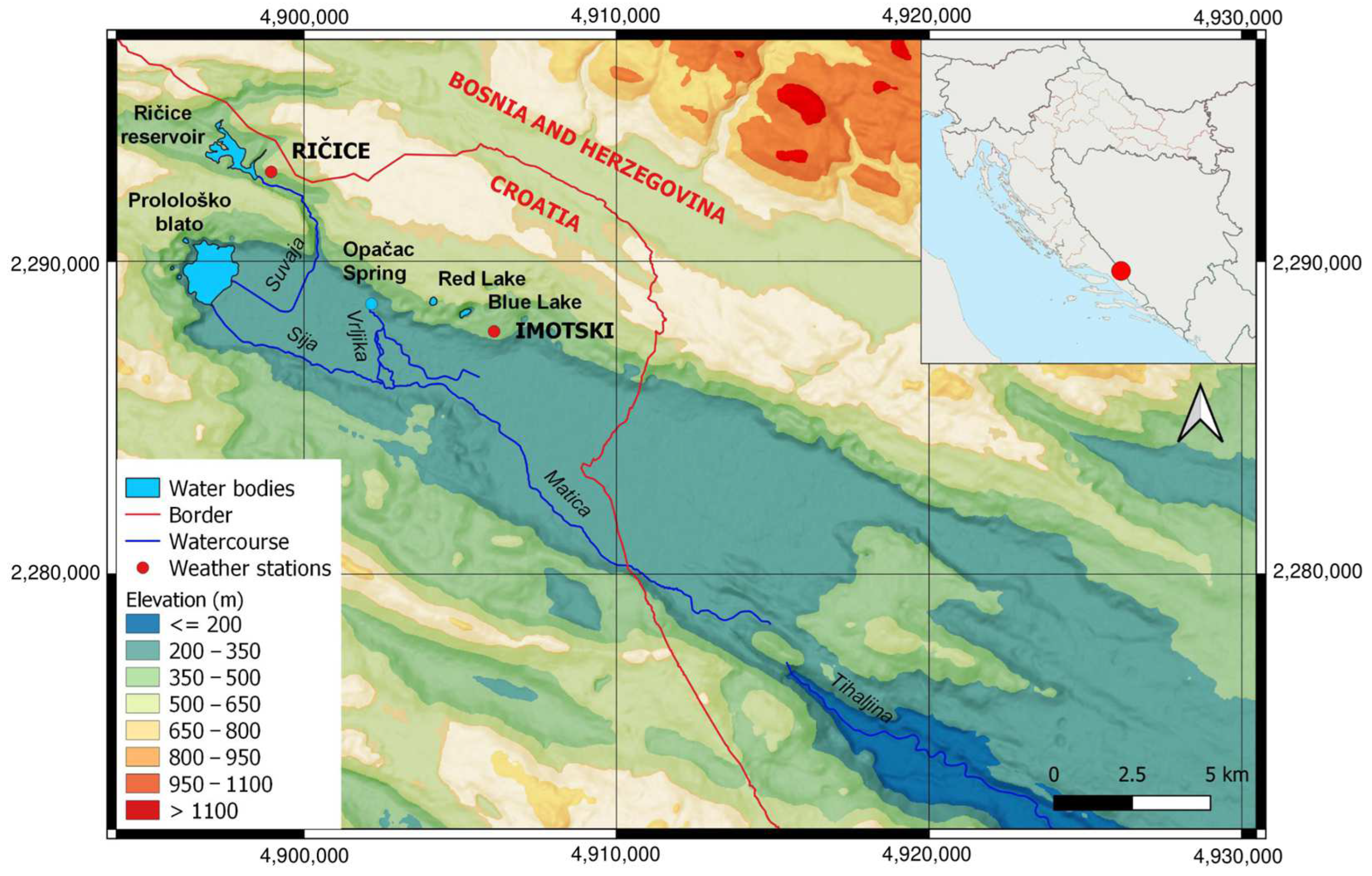
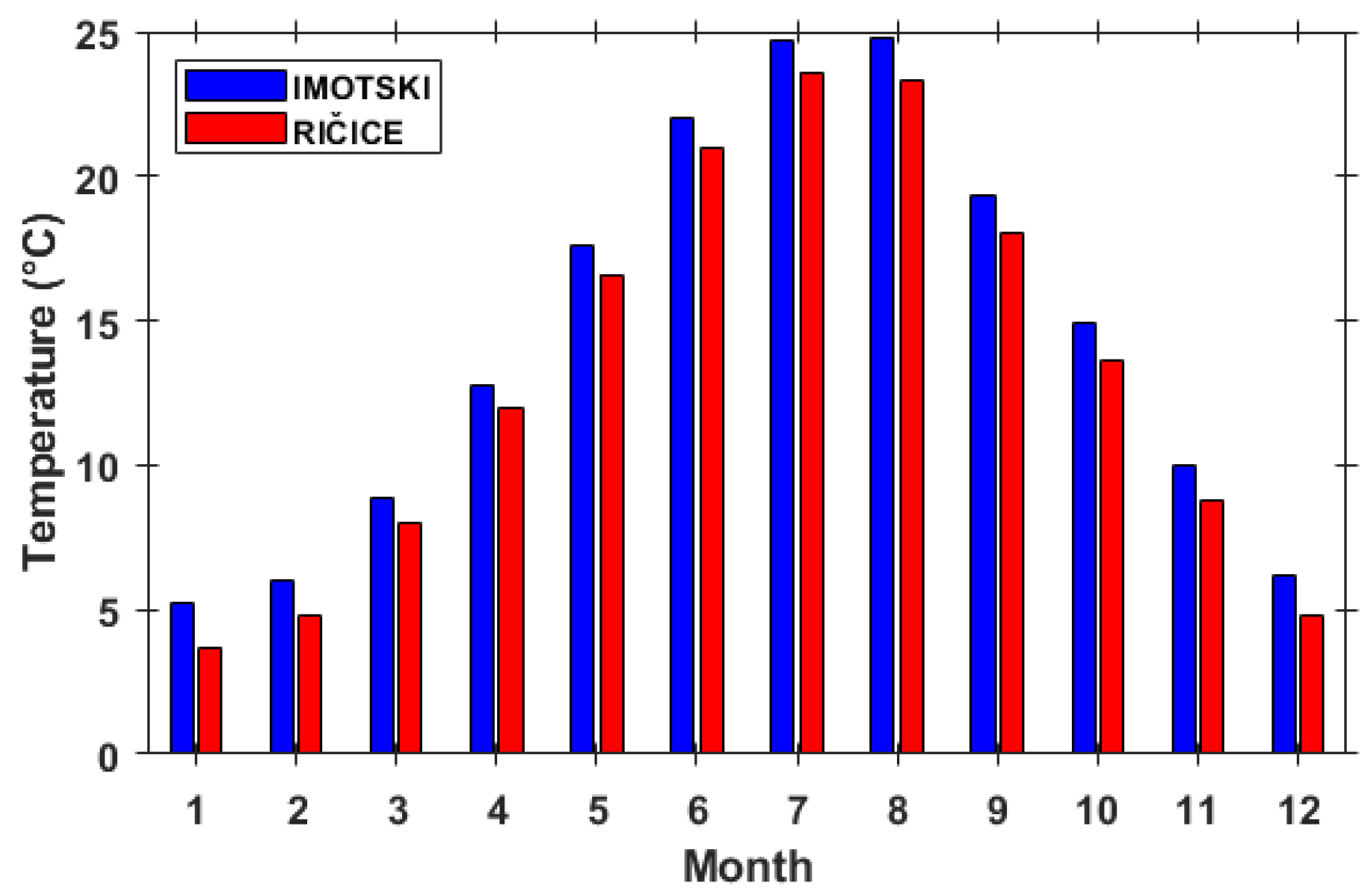


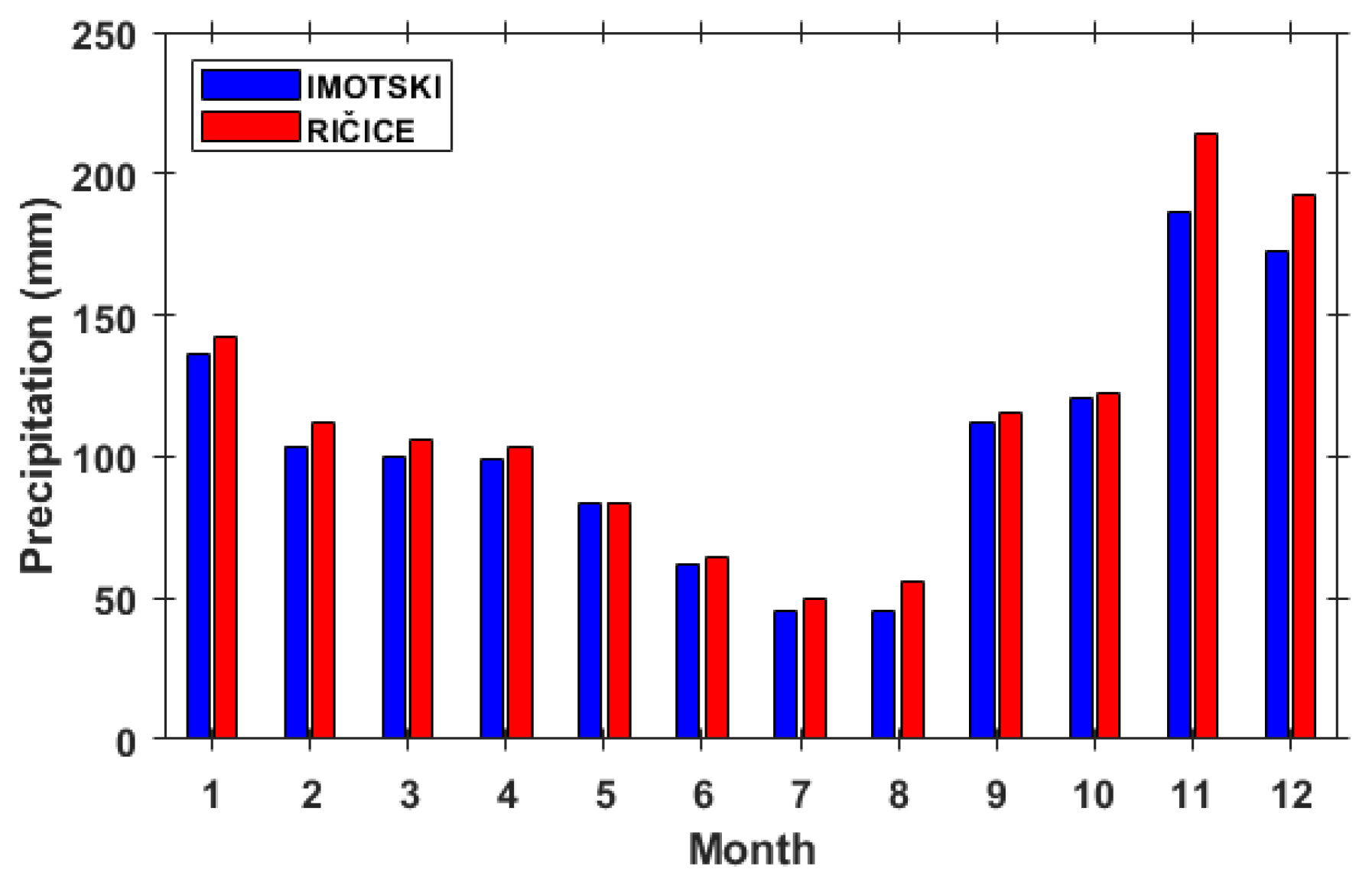
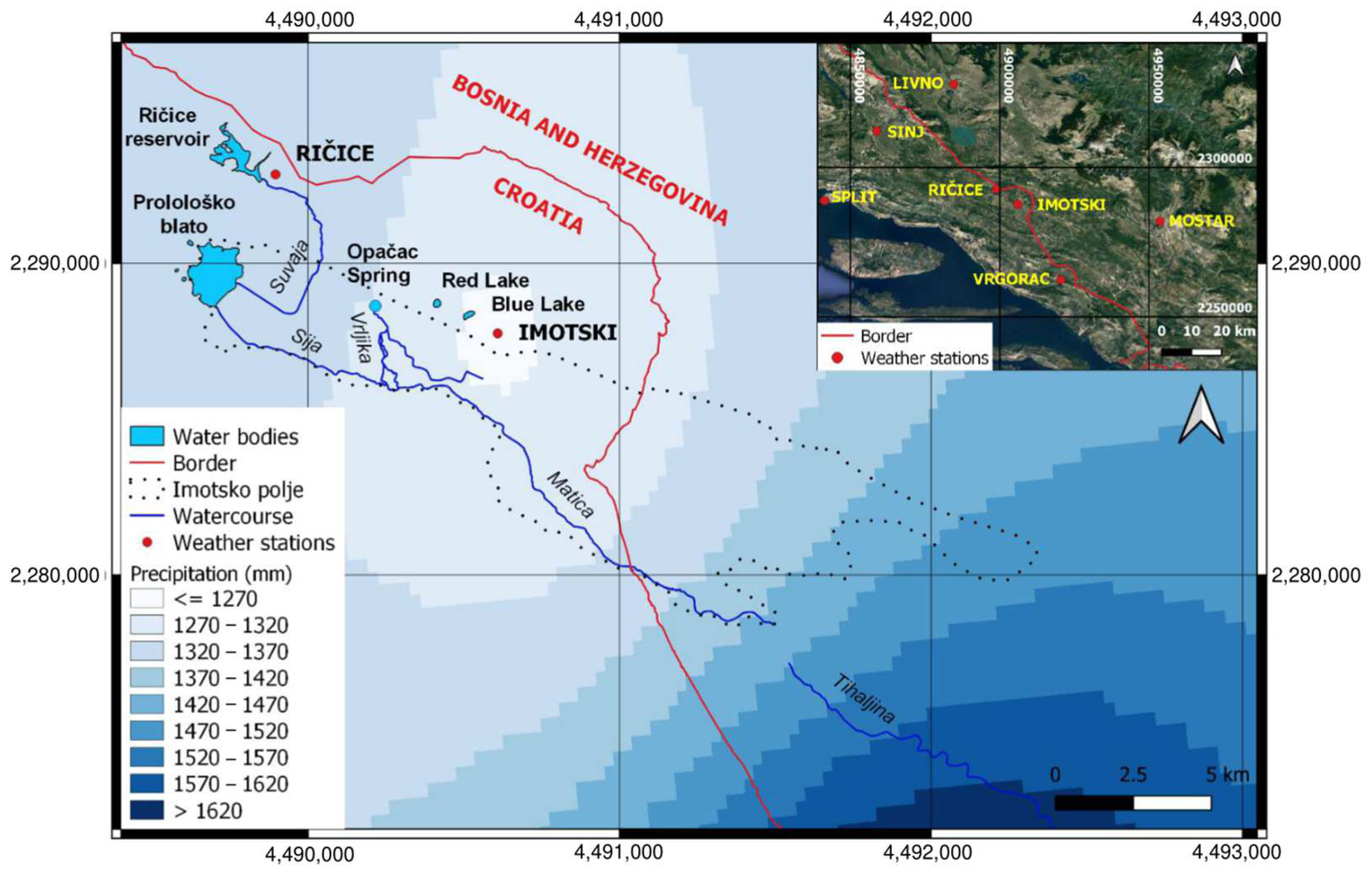
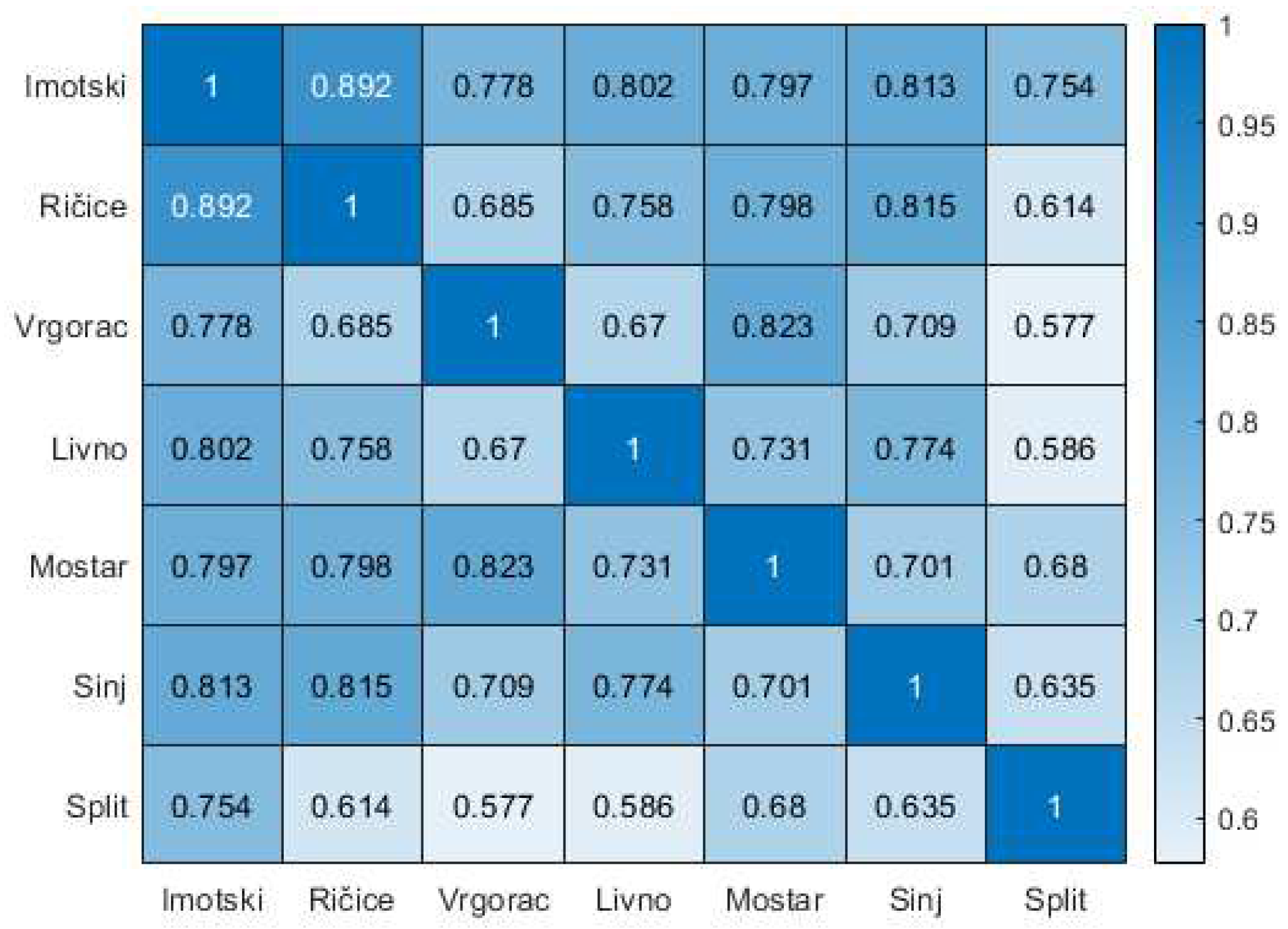




| S-Slope (β) | MK-Test (p) | |||
|---|---|---|---|---|
| Temperature (°C) | IM | RI | IM | RI |
| minimum | −0.0667 | −0.0510 | 0.0721 | 0.4092 |
| mean | 0.0437 | 0.0387 | * | * |
| maximum | 0.0813 | 0.0383 | 0.1131 | 0.1650 |
| Temperature (°C) | S-Slope (β) | MK-Test (p) |
|---|---|---|
| minimum | −0.0050 | 0.7670 |
| mean | 0.0437 | * |
| maximum | 0.0590 | 0.0131 * |
| Minimum | Mean | Maximum | CV | |||||
|---|---|---|---|---|---|---|---|---|
| Month | Imotski | Ričice | Imotski | Ričice | Imotski | Ričice | Imotski | Ričice |
| January | 1.4 | 2.6 | 136.4 | 142.1 | 310.7 | 313.1 | 65.4 | 64.0 |
| February | 0.7 | 1.4 | 103.8 | 112.1 | 236.7 | 238.4 | 61.1 | 61.9 |
| March | 0.0 | 0.1 | 99.8 | 105.9 | 259.1 | 276.1 | 72.3 | 71.8 |
| April | 21.6 | 6.3 | 98.9 | 103.6 | 202.3 | 223 | 42.8 | 50.1 |
| May | 13.6 | 11.2 | 83.2 | 83.8 | 201.5 | 177.4 | 51.8 | 54.2 |
| June | 7.9 | 4.3 | 62.2 | 64.1 | 256.1 | 178.2 | 87.3 | 68.2 |
| July | 1.8 | 2.8 | 45.2 | 49.5 | 164.3 | 225.6 | 89.8 | 104.8 |
| August | 0.0 | 0 | 45.2 | 56.1 | 238.9 | 236.9 | 109.0 | 93.2 |
| September | 21.9 | 26.5 | 112.0 | 115.1 | 340.4 | 307.9 | 63.5 | 61.3 |
| October | 12.6 | 7.5 | 120.7 | 122.3 | 281.2 | 298.7 | 64.1 | 56.2 |
| November | 47.0 | 54.1 | 186.2 | 214.2 | 361.2 | 470.1 | 49.4 | 56.5 |
| December | 0.0 | 0 | 172.7 | 192.4 | 444.9 | 450.2 | 62.3 | 61.3 |
| S-Slope (β) | MK-Test (p) | |
|---|---|---|
| Annual precipitation | 6.0575 | 0.1474 |
| S-Slope (β) | MK-Test (p) | |||
|---|---|---|---|---|
| Station | IM | RI | IM | RI |
| Annual precipitation | 4.7727 | −2.7693 | 0.5865 | 0.6936 |
| IMOTSKI | RIČICE | |||
|---|---|---|---|---|
| Pmax (mm) | T (Year) | Pmax (mm) | T (Year) | |
| annual | 1968.7 | 63 | 2093 | 36 |
| monthly | 444.9 | 100 | 313.1 | 50 |
Disclaimer/Publisher’s Note: The statements, opinions and data contained in all publications are solely those of the individual author(s) and contributor(s) and not of MDPI and/or the editor(s). MDPI and/or the editor(s) disclaim responsibility for any injury to people or property resulting from any ideas, methods, instructions or products referred to in the content. |
© 2023 by the authors. Licensee MDPI, Basel, Switzerland. This article is an open access article distributed under the terms and conditions of the Creative Commons Attribution (CC BY) license (https://creativecommons.org/licenses/by/4.0/).
Share and Cite
Vrsalović, A.; Andrić, I.; Bonacci, O.; Kovčić, O. Climate Variability and Trends in Imotski, Croatia: An Analysis of Temperature and Precipitation. Atmosphere 2023, 14, 861. https://doi.org/10.3390/atmos14050861
Vrsalović A, Andrić I, Bonacci O, Kovčić O. Climate Variability and Trends in Imotski, Croatia: An Analysis of Temperature and Precipitation. Atmosphere. 2023; 14(5):861. https://doi.org/10.3390/atmos14050861
Chicago/Turabian StyleVrsalović, Adrijana, Ivo Andrić, Ognjen Bonacci, and Omer Kovčić. 2023. "Climate Variability and Trends in Imotski, Croatia: An Analysis of Temperature and Precipitation" Atmosphere 14, no. 5: 861. https://doi.org/10.3390/atmos14050861
APA StyleVrsalović, A., Andrić, I., Bonacci, O., & Kovčić, O. (2023). Climate Variability and Trends in Imotski, Croatia: An Analysis of Temperature and Precipitation. Atmosphere, 14(5), 861. https://doi.org/10.3390/atmos14050861









